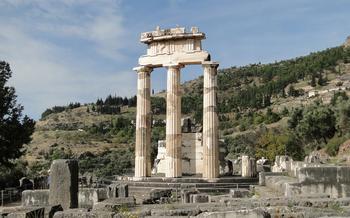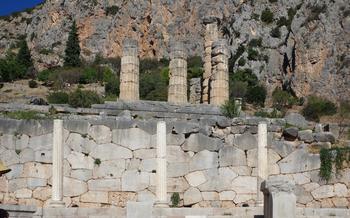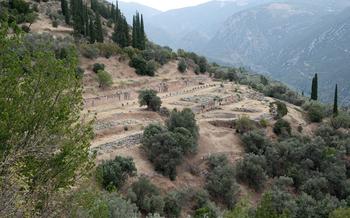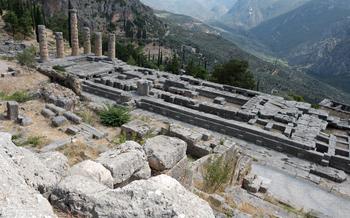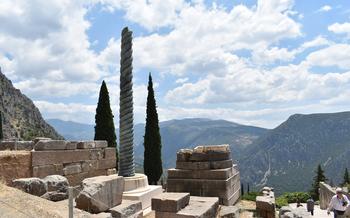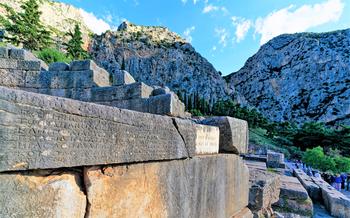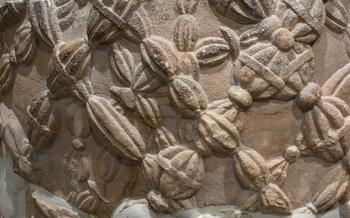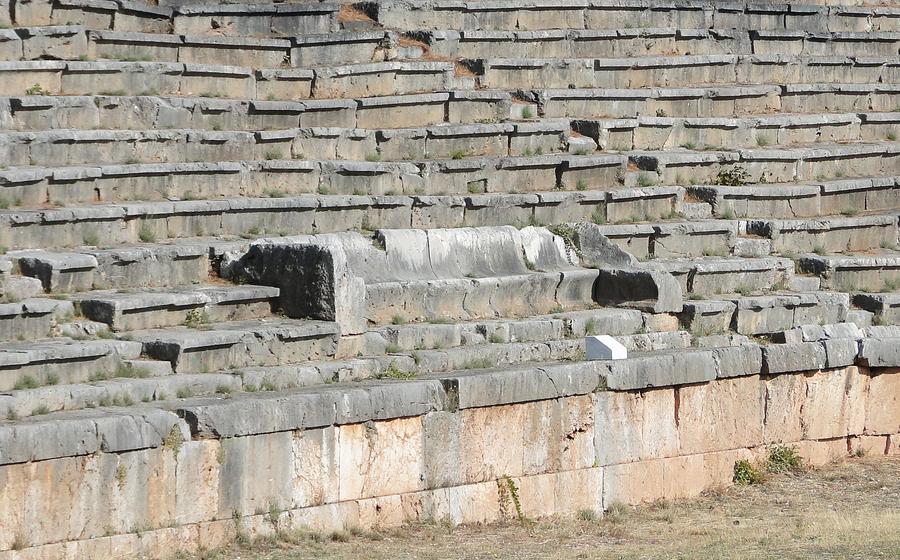
Ancient Stadium of Delphi
- Delphi: A Place of Antiquity and Wonder
- Unveiling the Ancient Stadium of Delphi
- A Journey Through Time: Exploring the Stadium's History
- The Stadium's Structure and Layout
- Witnessing the Grandeur of the Stadium's Architecture
- A Place of Triumph and Celebration
- The Spirit of Athleticism in Ancient Greece
- The Stadium's Role in the Pythian Games
- The Stadium's Legacy and Influence
- Practical Information for Visitors
- Delving into the Museum of Delphi
- Capturing the Essence of the Stadium
- A Stroll Through the Picturesque Surroundings
- Unveiling the Secrets of Archaeological Excavations
- Insider Tip: Discovering Hidden Gems
Delphi: A Place of Antiquity and Wonder
Delphi, a name synonymous with ancient Greek history and mythology, beckons travelers to a world of antiquity and wonder. Situated on the slopes of Mount Parnassus, this sacred city was considered the center of the world in ancient times and was revered as the home of the oracle of Apollo. The archaeological site of Delphi, a UNESCO World Heritage Site, is a treasure trove of ancient ruins, including the awe-inspiring stadium, which stands as a testament to the city's rich sporting heritage and cultural significance. With its stunning natural surroundings, Delphi offers a breathtaking backdrop for an unforgettable journey through time.
Historical Significance Delphi's history dates back to the Mycenaean period (1600-1100 BC), when it was already an important religious center. In the 8th century BC, the oracle of Apollo gained prominence, and Delphi became a renowned sanctuary and pilgrimage site for the ancient Greeks. The city flourished during the classical period (5th-4th centuries BC), reaching the height of its power and influence. Delphi's decline began in the Roman period, and by the 6th century AD, it was abandoned.
Mythological and Cultural Importance Delphi occupies a central place in Greek mythology. It was believed to be the site where the god Apollo slew the monstrous serpent Python and established his oracle. The oracle, delivered by the Pythia, a priestess of Apollo, was consulted by individuals, city-states, and rulers seeking guidance on important matters. Delphi's influence extended beyond religious matters, as it also became a center for cultural and artistic expression.
Archaeological Treasures The archaeological site of Delphi is a treasure trove of ancient ruins, including temples, theaters, treasuries, and the stadium. The Temple of Apollo, with its Doric columns and exquisite sculptures, is the most prominent structure. Other notable landmarks include the Treasury of the Athenians, the Tholos, and the Castalian Spring, where visitors can drink the sacred water that was believed to have inspired the oracle.
Stunning Natural Surroundings Delphi's natural surroundings are as breathtaking as its ancient ruins. The city is nestled on the slopes of Mount Parnassus, with stunning views of the valley and the distant mountains. The lush greenery and the fresh mountain air create a serene and tranquil atmosphere, making Delphi an ideal destination for those seeking a combination of history, culture, and natural beauty.
Unveiling the Ancient Stadium of Delphi
Nestled within the heart of the archaeological site of Delphi, the ancient stadium stands as a testament to the sporting prowess and cultural significance of ancient Greece. Built in the 5th century BC, the stadium hosted athletic competitions as part of the renowned Pythian Games, which were held every four years in honor of the god Apollo.
The stadium's location within the sacred sanctuary of Delphi, overlooking the dramatic valley and surrounded by majestic mountains, adds to its awe-inspiring presence. Its proximity to the Temple of Apollo and other significant religious structures highlights the deep connection between sports and religion in ancient Greek society.
The stadium's architectural features reflect the ingenuity and precision of ancient Greek engineering. Constructed from local limestone, the stadium boasts a U-shaped design with stepped seating rising from the track. The starting and finishing lines, still visible today, demonstrate the attention to detail and fairness in ancient sporting events.
From the stadium's elevated position, spectators enjoyed panoramic views of the surrounding landscape. The backdrop of the towering Mount Parnassus and the picturesque valley below created a breathtaking setting for the athletic competitions, adding to the excitement and grandeur of the Pythian Games.
A Journey Through Time: Exploring the Stadium's History
The Ancient Stadium of Delphi was not just a sporting arena; it was a stage for some of the most significant events in ancient Greek history and mythology. The stadium played a crucial role in the Pythian Games, which were held every four years in honor of the god Apollo. During the games, athletes from all over Greece competed in a variety of sporting events, including footraces, wrestling, boxing, and chariot races.
The stadium also hosted other important religious and cultural festivals, such as the Thargelia, which celebrated the ripening of the first fruits. These festivals were a time for people to come together, celebrate their shared heritage, and honor the gods.
The stadium's history is closely intertwined with the mythology and legends of ancient Greece. According to myth, the stadium was built by the hero Hercules after he defeated the three-headed monster Geryon. Hercules is said to have used the stadium to train for his many other legendary feats.
The stadium's rich history and mythological associations make it a truly special place. Visitors can almost feel the presence of the ancient athletes and spectators as they walk through the stadium and imagine the excitement and drama of the games.
The Stadium's Structure and Layout
The ancient stadium of Delphi showcases impressive dimensions, with a length of 175 meters and a width of 25 meters. It could accommodate approximately 6,500 spectators, who would witness the athletic competitions from the surrounding stone seats. The stadium's layout features a starting line marked with a row of stone blocks, while the finishing line is indicated by a curved stone structure. The track surface is composed of a compact layer of earth, providing a stable and level ground for the athletes. Remarkably, the stadium also incorporates a sophisticated drainage system, ensuring that rainwater is efficiently channeled away from the track, preventing any disruptions during competitions. The stadium's acoustics are equally impressive, allowing the spectators to clearly hear the sounds of the races and the cheers of the crowd, creating an immersive and vibrant atmosphere during the ancient sporting events.
Witnessing the Grandeur of the Stadium's Architecture
The Ancient Stadium of Delphi stands as a testament to the architectural prowess of ancient Greece. Constructed primarily of limestone and marble, the stadium has withstood the test of time, showcasing the remarkable building techniques and engineering skills of the ancient Greeks.
Well-preserved stone blocks form the foundation of the stadium, creating a sturdy and durable structure. Intricate architectural details, such as decorative moldings and cornices, adorn the stadium, adding to its aesthetic appeal. Supporting structures and retaining walls ensure the stability of the stadium, preventing erosion and collapse.
Unique features and engineering marvels set the Ancient Stadium of Delphi apart from other ancient stadiums. The drainage system, designed to channel rainwater away from the track, is a testament to the ingenuity of the ancient Greeks. The acoustics of the stadium are also noteworthy, allowing the roar of the crowd to resonate throughout the venue.
Exploring the Ancient Stadium of Delphi is a journey through time, allowing visitors to appreciate the architectural achievements of ancient Greece and marvel at the grandeur of this iconic sporting venue.
A Place of Triumph and Celebration
The Ancient Stadium of Delphi was not merely an arena for athletic competitions; it was a place where victors were celebrated and honored. The stadium witnessed countless triumphs and achievements, as athletes from across the Greek world competed for glory and recognition.
The victors of the Pythian Games were crowned with laurel wreaths, a symbol of their victory and excellence. This crowning ceremony was a solemn and prestigious event, held in front of a cheering crowd. The winners were hailed as heroes, and their names were inscribed on victory monuments, ensuring their legacy would live on for generations.
In ancient Greek society, athletic victories were highly valued and respected. Athletes who achieved success in the Pythian Games were celebrated not only for their physical prowess but also for their discipline, dedication, and perseverance. Their victories brought honor and prestige to their hometowns and families.
The stadium's atmosphere during these celebrations was electric, filled with excitement, pride, and camaraderie. The crowd erupted in cheers and applause, celebrating the achievements of their fellow Greeks. Music, dancing, and other festivities accompanied the games, creating a vibrant and joyous atmosphere that extended beyond the stadium walls.
The Spirit of Athleticism in Ancient Greece
Sports and physical fitness were highly valued in ancient Greece, and athletics was seen as a way to honor the gods and demonstrate physical prowess. Athletes trained rigorously to prepare for competitions, and victories were celebrated with great fanfare.
The Pythian Games, held every four years in Delphi, were one of the most prestigious athletic events in the ancient world. Athletes from all over Greece competed in a variety of sports, including running, wrestling, boxing, and chariot racing. Victors were crowned with laurel wreaths and hailed as heroes.
Athletic competitions in ancient Greece were not only about physical strength and skill, but also about demonstrating moral qualities such as courage, determination, and perseverance. Athletes were expected to compete fairly and honorably, and cheating was strictly forbidden.
The spirit of athleticism in ancient Greece is still alive today. The Olympic Games, which were inspired by the ancient Greek games, are a celebration of human achievement and the pursuit of excellence. The values of sportsmanship, fair play, and teamwork that are central to the Olympic Games can be traced back to the ancient Greek tradition of athletics.
The Stadium's Role in the Pythian Games
The Ancient Stadium of Delphi played a pivotal role in the Pythian Games, one of the four major Panhellenic religious festivals in ancient Greece. Held in honor of the god Apollo, the Pythian Games were celebrated every four years, attracting athletes, pilgrims, and visitors from all corners of the Greek world.
During the Pythian Games, the stadium hosted a variety of athletic competitions, including footraces, wrestling, boxing, and chariot racing. The most prestigious event was the stadion race, a short sprint that determined the overall victor of the games. Winners of the Pythian Games were crowned with laurel wreaths and hailed as heroes in their hometowns.
In addition to athletic competitions, the Pythian Games also featured cultural and artistic events, such as musical performances, poetry recitals, and theatrical productions. The games were a time of celebration and festivity, bringing together people from different cities and regions to honor Apollo and showcase their talents.
The Panhellenic importance of the Pythian Games and the prestige associated with victory in the stadium contributed to Delphi's status as a major religious and cultural center in ancient Greece. The stadium remains a testament to the significance of the games and the athletic spirit that was so highly valued in ancient Greek society.
The Stadium's Legacy and Influence
The Ancient Stadium of Delphi, as the birthplace of organized athletic competitions, played a pivotal role in shaping the development of sports and athletics in ancient Greece and beyond. Its legacy extended far beyond the realm of sporting events, serving as a model for future sporting venues and inspiring the construction of modern Olympic stadiums. The stadium's enduring significance lies in its representation of ancient Greek culture and heritage, embodying the ideals of physical excellence, competition, and the pursuit of victory.
The stadium's impact on the development of modern sports cannot be overstated. Its design and layout served as a blueprint for future sporting arenas, with its oval shape, starting and finishing lines, and seating arrangements becoming standard features of athletic facilities around the world. The stadium's legacy is particularly evident in the construction of modern Olympic stadiums, which often draw inspiration from the ancient Greek model.
Beyond its architectural influence, the Ancient Stadium of Delphi represents the spirit of athleticism that characterized ancient Greek culture. The stadium's existence underscores the importance placed on physical fitness and sports in ancient Greece, where athletic competitions were seen as a means of honoring the gods, promoting physical excellence, and fostering a sense of unity among the Greek city-states.
The stadium's enduring legacy lies in its embodiment of the ideals of ancient Greek culture. It stands as a testament to the pursuit of excellence, the celebration of human achievement, and the enduring power of sports to unite and inspire. The stadium's influence on modern sports and its representation of ancient Greek heritage ensure that its legacy will continue to shape the world of athletics for generations to come.
Practical Information for Visitors
The Ancient Stadium of Delphi is a popular tourist destination and is easily accessible. It is located within the archaeological site of Delphi, which is situated in the picturesque valley of Phocis, about 125 kilometers northwest of Athens. The site is open to the public daily, and admission fees apply. Guided tours and audio guides are available to enhance your visit and provide insights into the stadium's history and significance.
To make the most of your visit, plan to spend at least an hour exploring the stadium and the surrounding area. Wear comfortable shoes as you will be doing a lot of walking on uneven surfaces. The site is partially accessible for visitors with disabilities, but some areas may be challenging to navigate. Facilities such as restrooms, a cafeteria, and a gift shop are available for visitors' convenience.
Before your visit, consider checking the official website of the archaeological site of Delphi for the most up-to-date information on opening hours, admission fees, and special events. Embark on a journey through time as you explore the Ancient Stadium of Delphi and discover the rich history and legacy of this iconic sporting venue.
Delving into the Museum of Delphi
A visit to the Museum of Delphi is an essential complement to exploring the Ancient Stadium. The museum houses a wealth of artifacts and exhibits that provide insights into the history, significance, and cultural context of the stadium.
Among the highlights of the museum's collection are ancient sculptures, inscriptions, and pottery related to the stadium. These artifacts offer glimpses into the athletic competitions and festivals held in the stadium, as well as the religious and cultural significance of these events in ancient Greek society.
The museum also features exhibits that delve into the history and construction of the stadium. Visitors can learn about the architectural techniques used to build the stadium, the materials employed, and the challenges faced by ancient engineers in creating such an impressive structure.
By exploring the Museum of Delphi, visitors can gain a deeper understanding of the Ancient Stadium and its role in the religious, cultural, and sporting traditions of ancient Greece. The museum's exhibits bring the stadium's history to life, providing a fascinating complement to the experience of visiting the stadium itself.
Capturing the Essence of the Stadium
The ancient stadium of Delphi is a photographic dream, with its majestic stone structure set against a backdrop of rugged mountains and lush valleys. To capture the stadium's beauty, come prepared with a good camera and a tripod. The best time to visit is in the early morning or late afternoon, when the light is soft and golden. Experiment with different angles to find the perfect composition, and don't be afraid to get creative with your shots. Try capturing the stadium from a low angle to emphasize its grandeur, or from a high angle to showcase its panoramic views.
Beyond capturing the stadium's physical beauty, try to convey its atmosphere and history through your photographs. Imagine the roar of the crowd as ancient athletes competed for glory, and let that energy infuse your images. Look for details that tell a story, such as the worn steps of the seating tiers or the intricate carvings on the stone blocks. By capturing the essence of the stadium, you'll create a lasting memory of this iconic site. Share your experiences and photographs on social media, using hashtags like #DelphiStadium and #AncientGreece to connect with fellow travelers and history enthusiasts.
A Stroll Through the Picturesque Surroundings
Beyond the confines of the ancient stadium, the archaeological site of Delphi offers a wealth of other wonders to explore. Embark on a journey through time as you wander among the ruins of the Temple of Apollo, where the oracle once delivered her enigmatic prophecies. Marvel at the intricate carvings and well-preserved frescoes that adorn the temple's facade, providing a glimpse into the artistry and religious beliefs of ancient Greece.
Venture further into the site and discover the ruins of other significant structures, including the Treasury of Athens, the Stoa of Attalos, and the theater. Each of these landmarks holds its own unique story, offering insights into the political, cultural, and religious life of ancient Delphi.
As you explore, take a moment to soak in the breathtaking views that surround the archaeological site. The valley of Delphi, with its patchwork of olive groves and vineyards, stretches out before you, framed by the majestic peaks of Mount Parnassus. The natural beauty of the surroundings adds to the mystical and awe-inspiring atmosphere of Delphi, creating a truly unforgettable experience.
Whether you choose to wander aimlessly or follow a guided tour, the archaeological site of Delphi is a place where history, nature, and spirituality intertwine. Take your time to explore, discover, and connect with the spirit of this ancient oracle center, where the secrets of the past still linger in the air.
Unveiling the Secrets of Archaeological Excavations
The ancient stadium of Delphi continues to be a site of active archaeological excavations, yielding new discoveries that shed light on its history and significance. Archaeologists meticulously uncover the secrets hidden beneath the earth, uncovering artifacts, inscriptions, and structural remains that provide valuable insights into the stadium's past.
Ongoing excavations have revealed previously unknown features of the stadium, such as additional seating areas, training facilities, and water management systems. These discoveries challenge existing theories and provide a more comprehensive understanding of the stadium's design and function.
Archaeologists also explore the surrounding areas of the stadium, uncovering ancient pathways, workshops, and living quarters. These findings offer glimpses into the daily lives of athletes, officials, and spectators who frequented the stadium during ancient times.
Visitors to Delphi have the unique opportunity to witness archaeological excavations firsthand. Guided tours often include visits to active dig sites, where archaeologists explain their methods and share their latest findings. These tours provide an immersive and educational experience, allowing visitors to connect with the history of the stadium and gain a deeper appreciation for the work of archaeologists.
Insider Tip: Discovering Hidden Gems
Beyond the main attractions of the archaeological site, there are hidden gems waiting to be discovered by curious explorers. Venture off the beaten path and uncover lesser-known areas that offer a glimpse into the secluded corners of ancient Delphi.
Follow the winding paths that lead to tranquil spots, where you can find respite from the crowds and immerse yourself in the serenity of the surroundings. These hidden oases offer a unique perspective on the ancient city, allowing you to connect with the past in a more intimate and personal way.
As you explore the nooks and crannies of the site, keep an eye out for intriguing ruins, forgotten inscriptions, and enigmatic artifacts. Each discovery adds another layer to the rich tapestry of Delphi's history, providing a deeper understanding of the lives and culture of its ancient inhabitants.
Whether you're a seasoned history buff or simply seeking a moment of tranquility, exploring the hidden gems of Delphi is an unforgettable experience that will leave you with a lasting appreciation for this extraordinary place. So embrace your inner explorer, let your curiosity guide you, and uncover the secrets that Delphi holds within its ancient walls.
